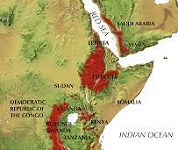The second anniversary of the “Nature-based Solutions for Water Resources Infrastructure and Community Resilience in Ethiopia” project was marked yesterday at Geferessa in Oromia region of Ethiopia.
This signature biodiversity project launched by the Economic Commission for Africa (ECA) in partnership with Ethiopia’s Ministry of Water, Irrigation and Energy last year promotes the sustainable management of the catchment areas within select critical energy infrastructure zones notably hydropower dams by deploying nature-based solutions.
The Technology, Climate Change and Natural Resources Division (TCND) of the ECA is the project’s lead. This afforestation initiative is a model case-study reflecting ECA’s latest quest espoused in its ground-breaking Building Forward for an African Green Recovery Report, which it launched earlier in the year calling for intensive nature-based solutions to address climate change and boost Africa’s sustainable economic recovery.
Improving the livelihoods of the local communities through intensive reforestation, protection of water catchment areas, provisioning of fruit trees, fodder rich foliage, energy-saving stoves and eco-friendly livelihoods are among the key goals of this greening initiative.
It was launched last year in August among the Geferessa Community in Yeka Sub-City, of Addis Ababa. The principal implementers of the initiative are the ECA and the Ministry of Water, Irrigation and Energy but it is also expected to forge closer working links with the United Nations Environment Programme (UNEP), Wereda Natural Resources Department, local communities, development partners and international organisations.
The project which unleashes nature-based solutions (NbS) to enhance community resilience and ecosystems support services within catchment areas of selected hydropower dams’ infrastructure is in line with Ethiopia’s Climate Resilient Green Economy (CRGE) strategy.
“Investing in nature-based solutions implies setting aside terrestrial and marine protected areas, or rehabilitating areas to provide resilience to climate change and reduce risks.” Jean Paul Adam, the Director, Technology, Climate Change and Natural Resources Division (TCND) at ECA says. “The safeguarding of water supply catchment zones, reducing risks and reclaiming degraded environments enhances Africa’s resilience and natural capital.”
Now in its second year, the four-year project is expected to increase Ethiopia’s carbon sequestration capabilities; rehabilitate degraded lands through natural soil enrichment, build communal and infrastructure resilience, enhance Institutional and local communities’ capacities as well as reduce the carbon footprint of the ECA and sister UN agencies based in Ethiopia.
The project that promotes biodiversity restoration through the planting of indigenous and select nitrogen-fixing exotic tree species underscores Ethiopia’s Prime Minister Dr Abiy Ahmed’s Green Legacy Initiative that promotes afforestation as a counter to climate change. The Green Legacy Initiative is cited as a case study of African success through nature-based solutions.

